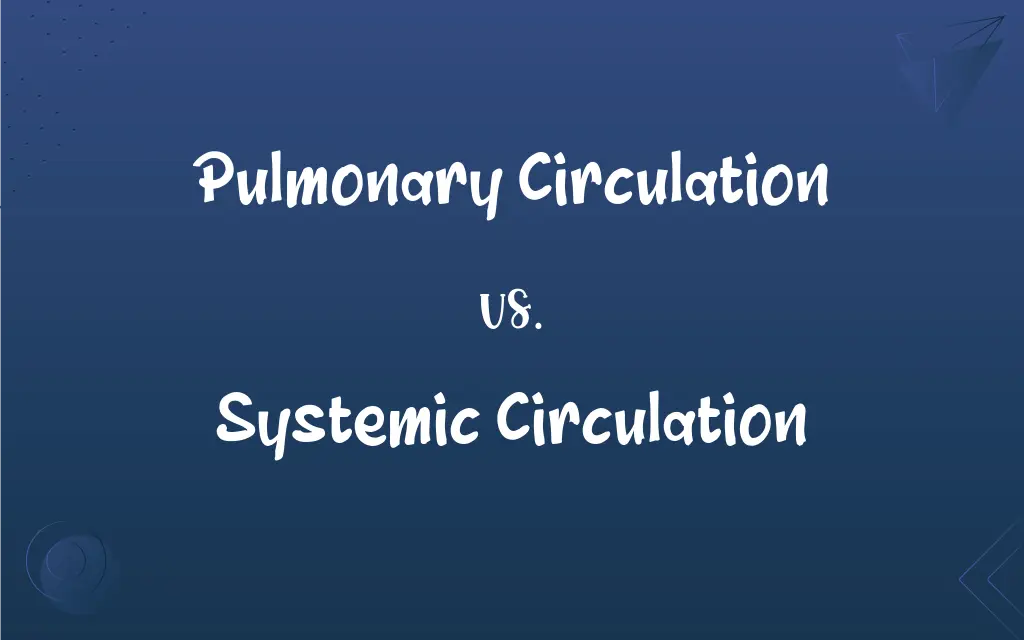Pulmonary Circulation vs. Systemic Circulation: What's the Difference?
Edited by Aimie Carlson || By Harlon Moss || Updated on October 18, 2023
Pulmonary circulation moves blood between the heart and lungs; systemic circulation delivers blood to the rest of the body.

Key Differences
The cardiovascular system is a complex network ensuring oxygen and nutrient delivery to cells. At its core are two main circulatory pathways: pulmonary circulation and systemic circulation. Pulmonary circulation specifically refers to the movement of blood between the heart and the lungs. It's the mechanism by which deoxygenated blood gets oxygenated. Conversely, systemic circulation ensures that this freshly oxygenated blood is delivered to various body tissues, organs, and cells.
Pulmonary circulation is crucial for oxygenating blood. Deoxygenated blood from the body flows into the right atrium of the heart, then to the right ventricle, which pumps it to the lungs. In the lungs, carbon dioxide is exchanged for oxygen. Systemic circulation starts when the left atrium receives this oxygen-rich blood, allowing the left ventricle to pump it throughout the body.
It's interesting to note that while pulmonary circulation involves just the heart and lungs, systemic circulation is far more extensive. It channels oxygen-rich blood to every part of the body, returning deoxygenated blood back to the heart. Despite their distinct routes and functions, pulmonary circulation and systemic circulation are interconnected, ensuring a continuous flow of blood.
The distinctions between pulmonary circulation and systemic circulation aren't just anatomical but also functional. While pulmonary circulation focuses on oxygenation, systemic circulation is responsible for nourishing and removing waste from body cells. Both systems are vital for maintaining life, ensuring cells receive oxygen and nutrients while eliminating waste.
Pulmonary circulation and systemic circulation together create a closed-loop system. This ensures that blood circulates continuously, making efficient use of a finite volume of blood. The heart acts as the central pump, driving both the pulmonary and systemic circulations, highlighting the intricate design and functionality of the human body.
ADVERTISEMENT
Comparison Chart
Function
Oxygenates deoxygenated blood
Delivers oxygenated blood to the body
Primary Organs
Heart and lungs
Heart and all other body organs
Blood Type
Carries deoxygenated blood to the lungs and returns oxygenated blood to the heart
Carries oxygenated blood from the heart to the body and returns deoxygenated blood back to the heart
Pathway Start
Right atrium of the heart
Left atrium of the heart
Purpose
Carbon dioxide and oxygen exchange
Delivers nutrients and oxygen, removes waste
ADVERTISEMENT
Pulmonary Circulation and Systemic Circulation Definitions
Pulmonary Circulation
The flow of blood from the heart to the lungs and back.
In pulmonary circulation, blood gets oxygenated in the lungs before returning to the heart.
Systemic Circulation
Blood movement that nourishes the body.
Systemic circulation is crucial for delivering oxygen and nutrients to cells.
Pulmonary Circulation
Blood movement dedicated to oxygenation.
The main role of pulmonary circulation is to oxygenate blood and remove carbon dioxide.
Systemic Circulation
The pathway for oxygen and nutrient distribution throughout the body.
Any obstruction in systemic circulation can have widespread effects on health.
Pulmonary Circulation
The process where deoxygenated blood is sent to the lungs.
Pulmonary circulation helps in exchanging carbon dioxide for oxygen.
Systemic Circulation
Circulatory route serving the entire body except the lungs.
Systemic circulation ensures that every cell receives the necessary nutrients.
Pulmonary Circulation
The pathway facilitating lung-based blood oxygenation.
Disorders in pulmonary circulation can impact oxygen levels in the blood.
Systemic Circulation
The process of delivering oxygenated blood to body tissues.
Issues in systemic circulation can affect the entire body's oxygen supply.
Pulmonary Circulation
Circulatory route between the heart and lungs.
Pulmonary circulation ensures the blood is replenished with oxygen.
Systemic Circulation
The flow of oxygenated blood from the heart to the body and back.
Systemic circulation nourishes tissues and organs with oxygen-rich blood.
FAQs
Where does systemic circulation begin?
It starts from the left atrium of the heart.
How does systemic circulation differ from pulmonary circulation?
Systemic circulation delivers oxygenated blood to the whole body, whereas pulmonary circulation focuses on oxygenating blood.
Which part of the heart is central to pulmonary circulation?
The right atrium and right ventricle are key to pulmonary circulation.
What is pulmonary circulation?
It's the flow of blood between the heart and the lungs.
How does systemic circulation support body functions?
It delivers nutrients and oxygen to body cells and removes waste.
What's the primary role of pulmonary circulation?
To oxygenate deoxygenated blood and remove carbon dioxide in the lungs.
What could happen if systemic circulation is compromised?
Body cells might not get adequate oxygen or nutrients, leading to health issues.
Is pulmonary circulation shorter than systemic circulation?
Yes, pulmonary circulation is a shorter loop, involving just the heart and lungs.
What type of blood is predominant in systemic circulation?
Oxygenated blood, which is delivered to the body's cells.
How does systemic circulation impact overall health?
It ensures every part of the body receives oxygenated blood, which is crucial for cell function and health.
What powers both pulmonary and systemic circulations?
The heart acts as the central pump for both circulatory systems.
Why are both pulmonary and systemic circulations essential?
Together, they ensure continuous blood flow, oxygenation, nutrient delivery, and waste removal, which are vital for survival.
Can issues in pulmonary circulation affect systemic circulation?
Yes, if blood isn't properly oxygenated in pulmonary circulation, systemic circulation can deliver less oxygen to the body.
Which circulation route is longer?
Systemic circulation is longer as it serves the entire body.
Do pulmonary and systemic circulations operate independently?
While they have distinct functions, they're interconnected and reliant on each other.
Can problems in systemic circulation influence pulmonary circulation?
Indirectly, yes. If tissues can't use oxygen efficiently, it might affect the deoxygenation rate and impact pulmonary circulation.
Which type of blood does pulmonary circulation mainly carry?
It mainly carries deoxygenated blood to the lungs and returns oxygenated blood to the heart.
How do the lungs play a role in pulmonary circulation?
Lungs oxygenate the blood and remove carbon dioxide during pulmonary circulation.
How are pulmonary and systemic circulations connected?
They're interconnected by the heart, which pumps blood through both systems.
Why is pulmonary circulation vital for oxygenation?
It facilitates the exchange of carbon dioxide for oxygen in the lungs.
About Author
Written by
Harlon MossHarlon is a seasoned quality moderator and accomplished content writer for Difference Wiki. An alumnus of the prestigious University of California, he earned his degree in Computer Science. Leveraging his academic background, Harlon brings a meticulous and informed perspective to his work, ensuring content accuracy and excellence.
Edited by
Aimie CarlsonAimie Carlson, holding a master's degree in English literature, is a fervent English language enthusiast. She lends her writing talents to Difference Wiki, a prominent website that specializes in comparisons, offering readers insightful analyses that both captivate and inform.































































